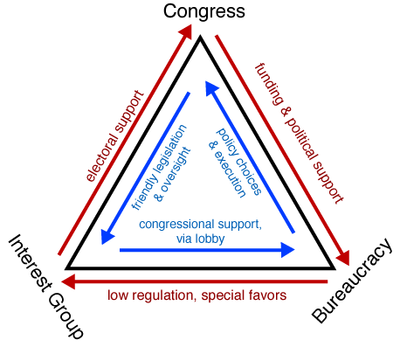|
There is a strong theory held among political scientists that suggests there is a solid triangle between interest groups
(people with money), beurocratic lobbiests, and House of Representative sub-committees. The fat cats within our society that
can fund their cause are the only ones that get representation in the House. Which is in turn only regulated by beurocratic
agencies. Its this circle alone that truely effects law making and legislation.
Public Interest
\/
House Sub-Committees /\
\/
Beurocratic agencies /\
The lower to middle class or "working class" is isolated. Only the rich get laws made in thier favor. This ignores true
Democracy of the people, creating factions for the sake of status.

Wikipedia explanation:::....
In United States politics, the iron triangle is a term used by
political scientists to describe the policy-making relationship among the congressional committees, the bureaucracy (executive)
(sometimes called "government agencies"), and interest groups. For example, within the federal government the three
sides often consist of: various congressional committees, which are responsible for funding government programs and operations
and then providing oversight of them; the federal agencies (often Independent agencies), which are responsible for the regulation
of those affected industries; and last, the industries themselves, as well as their trade associations and lobbying groups,
which benefit, or seek benefit, from these operations and programs. Probably the earliest concept of the "iron triangle"
was on January 17, 1919 by Ralph Pulitzer. It was the post World War I era when Pulitzer wrote a statement referring to the
Paris Peace Conference between the allied Governments. He stated, “Three forces are laboring for such a sinister peace:
(1,) the bourbonism of politicians…; (2,) the materialism of industrial…; (3,) the militarism of professional
soldiers…” and “If the Peace Conference is allowed to remain between governments instead of between peoples
it is apt to degenerate…” An often-used example of the term is with reference to the military-industrial
complex, with Congress (and the House and Senate Committees on Armed Services), defense contractors, and the U.S. Department
of Defense forming the iron triangle. The term iron triangle has been widely used by political scientists outside the United
States and is today an accepted term in the field.
|

